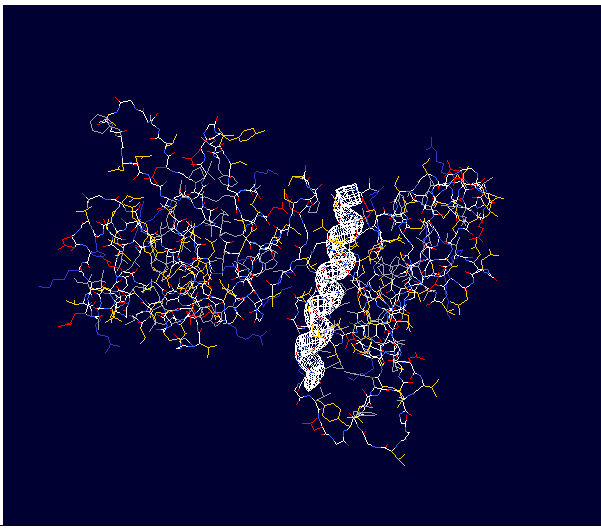Pilin
From Proteopedia
(→Introduction) |
|||
| Line 5: | Line 5: | ||
<br> | <br> | ||
==Introduction== | ==Introduction== | ||
| - | Type IV pili play an important role in the pathogenesis of many bacterial species; they are a required component for the adhesion of bacteria to their target cells. For example, Type IV pili are required for infection by the pathogens that cause cholera, typhoid, pneumonia, gonorrhea, and meningitis <ref name=journal1>PMID:19626704</ref>. They may also mediate transformation, modulate target-cell specificity and play a role in twitching motility <ref name=journal2>Asha M. Balakrishna,Yvonne Yih-Wan Tan, Henry Yu-Keung Mok,Anand M. Saxena,and Kunchithapadam Swaminathan. Crystallization and preliminary X-ray diffraction analysis of Salmonella typhi PilS. 2006 October 1; 62(Pt 10): 1024–1026</ref>. Specifically, the type IVb pilus of ''Salmonella typhi'' is the adhesion factor that allows the pathogen to enter into the gastrointestinal cells of animals <ref name=journal1>PMID:19626704</ref>. | + | Type IV pili play an important role in the pathogenesis of many bacterial species; they are a required component for the adhesion of bacteria to their target cells. For example, Type IV pili are required for infection by the pathogens that cause cholera, typhoid, pneumonia, gonorrhea, and meningitis <ref name=journal1>PMID:19626704</ref>. They may also mediate transformation, modulate target-cell specificity and play a role in twitching motility <ref name=journal2>Asha M. Balakrishna,Yvonne Yih-Wan Tan, Henry Yu-Keung Mok,Anand M. Saxena,and Kunchithapadam Swaminathan. Crystallization and preliminary X-ray diffraction analysis of Salmonella typhi PilS. 2006 October 1; 62(Pt 10): 1024–1026</ref>. Specifically, the type IVb pilus of ''Salmonella typhi'' is the adhesion factor that allows the pathogen to enter into the gastrointestinal cells of animals <ref name=journal1>PMID:19626704</ref>. |
==Structure== | ==Structure== | ||
| - | Type IV pilin are homopolymers, composed of a single-chain pilin protein <ref name=journal1>PMID:19626704</ref>. | + | Type IV pilin are homopolymers, composed of a single-chain pilin protein. A conserved 25 residue hydrophobic N terminal sequence is shared by all type IV pilins, a conserved pilus assembly machinery, and a unique N-methylated N-terminus <ref name=journal1>PMID:19626704</ref>. |
[[Image:N_Teeerminal_Hydrophobic.png|alt text]] | [[Image:N_Teeerminal_Hydrophobic.png|alt text]] | ||
| Line 15: | Line 15: | ||
==Function== | ==Function== | ||
| - | + | Type IVb pili are diverse in function; they mediate numerous cellular functions via their polymeric machinery. These functions include cell adhesion, signaling, phage attachment, surface motility, biofilm formation and DNA uptake by natural transformation <ref name=journal1>PMID:19626704</ref>. | |
Revision as of 00:48, 26 March 2010
Contents |
Salmonella typhi type IVb pilin (PilS)
Introduction
Type IV pili play an important role in the pathogenesis of many bacterial species; they are a required component for the adhesion of bacteria to their target cells. For example, Type IV pili are required for infection by the pathogens that cause cholera, typhoid, pneumonia, gonorrhea, and meningitis [1]. They may also mediate transformation, modulate target-cell specificity and play a role in twitching motility [2]. Specifically, the type IVb pilus of Salmonella typhi is the adhesion factor that allows the pathogen to enter into the gastrointestinal cells of animals [1].
Structure
Type IV pilin are homopolymers, composed of a single-chain pilin protein. A conserved 25 residue hydrophobic N terminal sequence is shared by all type IV pilins, a conserved pilus assembly machinery, and a unique N-methylated N-terminus [1].
Function
Type IVb pili are diverse in function; they mediate numerous cellular functions via their polymeric machinery. These functions include cell adhesion, signaling, phage attachment, surface motility, biofilm formation and DNA uptake by natural transformation [1].
References
- ↑ 1.0 1.1 1.2 1.3 Balakrishna AM, Saxena AM, Mok HY, Swaminathan K. Structural basis of typhoid: Salmonella typhi type IVb pilin (PilS) and cystic fibrosis transmembrane conductance regulator interaction. Proteins. 2009 Nov 1;77(2):253-61. PMID:19626704 doi:10.1002/prot.22500
- ↑ Asha M. Balakrishna,Yvonne Yih-Wan Tan, Henry Yu-Keung Mok,Anand M. Saxena,and Kunchithapadam Swaminathan. Crystallization and preliminary X-ray diffraction analysis of Salmonella typhi PilS. 2006 October 1; 62(Pt 10): 1024–1026
Proteopedia Page Contributors and Editors (what is this?)
Michal Harel, Elyse Yaremco, David Canner, Andrea Gorrell, Alexander Berchansky

